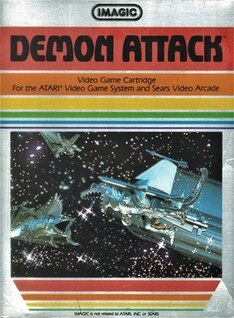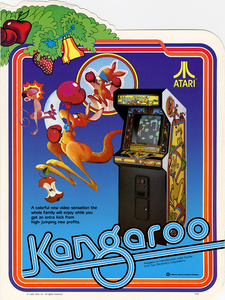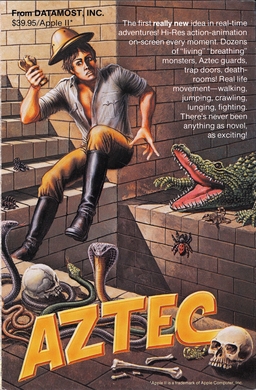
Kaboom! is an action video game published in 1981 by Activision for the Atari VCS. It was programmed by Larry Kaplan, and David Crane coded the overlaid sprites. The game was well received and sold over one million cartridges by 1983.

Tennis is a sports video game for the Atari VCS which was written by Activision co-founder Alan Miller and published by Activision in 1981.

Demon Attack is a fixed shooter written by Rob Fulop for the Atari 2600 and published by Imagic in 1982. It was ported to the Intellivision, Magnavox Odyssey 2, Atari 8-bit family, VIC-20, Commodore 64, IBM PC, TRS-80, IBM PCjr, and TRS-80 Color Computer. There is also a port for the TI-99/4A titled Super Demon Attack.

Kangaroo is a four-screen platform game released in arcades in 1982 by Sun Electronics and distributed in North America by Atari, Inc. Kangaroo is one of the first arcade games similar in style to Donkey Kong without being a direct clone. The player takes the role of a boxing glove-wearing mother kangaroo who is trying to rescue her joey from fruit-throwing monkeys.

Venture is a fantasy-themed action game released in arcades in 1981 by Exidy. The goal of Venture is to collect treasure from a dungeon as a round smiley-face named Winky. It was released as a launch title for the ColecoVision in 1982, then ported to the Atari 2600 and Intellivision.

Smurf: Rescue in Gargamel's Castle is a 1982 video game published and developed by Coleco for the ColecoVision and Atari 2600. The game is based on the television series The Smurfs. In the game, the player must brave a series of obstacles to rescue Smurfette from Gargamel's castle.

River Raid is a vertically scrolling shooter designed and programmed by Carol Shaw and published by Activision in 1982 for the Atari 2600 video game console. Over a million game cartridges were sold. Activision later ported the title to the Atari 5200, ColecoVision, and Intellivision consoles, as well as to the Commodore 64, IBM PCjr, MSX, ZX Spectrum, and Atari 8-bit family. Shaw did the Atari 8-bit and Atari 5200 ports herself.

Dodge 'Em is a driving-themed maze game programmed by Carla Meninsky and published in 1980 by Atari, Inc. for the Atari VCS. Similar to Sega's 1979 Head On arcade game, Dodge 'Em is played on a single screen of four concentric roadways. Sears released the game for the "Sears Video Arcade" as Dodger Cars.

Basketball is an Atari 2600 video game written by Alan Miller and published by Atari, Inc. in 1978. The cartridge presents a simple game of one-on-one basketball playable by one or two players, one of the few early Atari 2600 titles to have a single-player mode with an AI-controlled opponent. Miller wrote a version of Basketball for the Atari 8-bit family with improved graphics, published in 1979. That same year, an arcade version similar to the computer port was released by Atari but in black and white.

Bowling is a sports video game published in 1979 by Atari, Inc. for the Atari VCS. It was programmed by Larry Kaplan who left Atari to co-found Activision the same year. The game is an interpretation of the sport bowling, playable by one or two players.

Video Olympics is a video game programmed by Joe Decuir for the Atari 2600. It is one of the nine 2600 launch titles Atari, Inc. published when that system was released in September 1977. The cartridge is a collection of games from Atari's popular arcade Pong series. A similar collection in arcade machine form called Tournament Table was published by Atari in 1978.

Kick is an action video game where the player controls a clown on a unicycle catching falling balloons and Pac-Man characters on the clown's hat. It was released in arcades by Midway in 1981. The game was later renamed Kick Man. Commodore published a Commodore 64 port in 1982 without the space in the title as Kickman.

Megamania is an Atari 2600 game by Steve Cartwright and published by Activision in 1982. Versions were released for the Atari 5200 and Atari 8-bit family in 1983. Megamania is similar to Sega's 1981 arcade title Astro Blaster. Both games have nearly identical patterns of approaching enemies with the player relying on an "energy" meter. The player's ships are remarkably similar in both games.

Aztec is an action-adventure game developed by Paul Stephenson for the Apple II and published by Datamost in 1982. It was ported to the Atari 8-bit family and the Commodore 64. In Aztec, the player enters and explores the recently discovered "Tomb of Quetzalcoatl" in Mexico in search of a gold idol.

The Activision Decathlon is a sports game written by David Crane for the Atari 2600 and published by Activision in 1983. It was ported to the Atari 8-bit family, Atari 5200, Commodore 64, ColecoVision, and MSX. Up to four players compete in the ten different events of a real-life decathlon, either in sequence or individually.

Phaser Patrol, written by Dennis Caswell, is the first numbered release by Arcadia for the Atari 2600 and was the pack-in game for the Atari 2600 Supercharger accessory in 1982. The company changed its name to Starpath after launch, and the hardware was rebranded the Starpath Supercharger. The game simulates space combat in which the player pilots a ship to destroy the Dracon invaders.

Slot Racers is a video game for the Atari VCS published by Atari, Inc. in 1978. It was the first game written by Warren Robinett, who went on to create one of Atari's most successful games for the 2600, Adventure.

Space Cavern is a 1982 fixed shooter video game for the Atari 2600 developed and released by Games by Apollo. Players control a spaceship commander who has landed on a planet and must defend the ship against its hostile creatures. Games by Apollo founder Pat Roper was impressed by the game Demon Attack and tasked Apollo member Dan Oliver with making a game very similar to it.

Surround is a video game programmed by Alan Miller and published by Atari, Inc. for the Atari Video Computer System. It was one of the nine Atari VCS launch titles released in September 1977. Surround is an unofficial port of the arcade video game Blockade, released the previous year by Gremlin Industries. It is the first home console version of the game that became widely known across many platforms as Snake. Atari licensed it to Sears which released it under the name Chase.

Transylvania is an adventure video game published by Penguin Software. It was released for the Apple II in 1982 followed by ports to the Atari 8-bit family and Commodore 64. A Macintosh conversion was published in 1984, then versions for the Amiga, Atari ST, and MS-DOS in 1985.





















